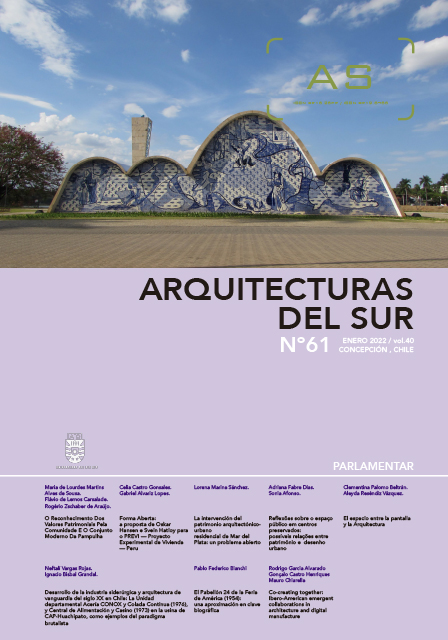The recognition of heritage values by the community and the Pampulha modern ensemble
DOI:
https://doi.org/10.22320/07196466.2022.40.061.01Keywords:
modern architecture, participatory management, cultural heritage, urban landscape, Pampulha Modern EnsembleAbstract
The Pampulha Modern Ensemble is an urban complex located in Belo Horizonte, Brazil, whose metropolitan context is highly problematic due to the pressures of urban dynamics, impacts from urban development and the need to manage changes and preserve architectural and landscape attributes that have led to its recognition as World Heritage. This article is part of a larger study that investigates the community's recognition of the values conferred by experts on that complex’s cultural landscape as a world heritage site. Due to the restrictive conditions imposed by the COVID 19 pandemic, an online questionnaire with open access to the general public was used as an instrument for the field research to collect primary data from the community. The analysis of the answers obtained from the questionnaire pre-test, object of this article, demonstrates the recognition of landscape elements and of the Pampulha Modern Ensemble that contribute to its fruition and that characterize it as a differentiated landscape in the context of the city.
Downloads
References
ÁBALOS, I. (2004). O que é a paisagem? Arquitextos Vitruvius, (05), 049.00. https://vitruvius.com.br/revistas/read/arquitextos/05.049/572/pt
BANDARIN, F., OERS, R. V. (2012). The historic urban landscape: managing heritage in an urban century. Wiley Blackwell.
CARSALADE, F. L. & SOUSA, M. L. M. A. (2020). Conjunto Moderno da Pampulha: evolução da sua gestão desde a sua candidatura a patrimônio mundial da humanidade. In: Amoroso, M. R., Guimaraens, C., Dias, D., Costa, A. & Tavares, A. (Orgs.). Patrimônio Arquitetônico Brasil – Portugal. (pp. 129-138). Proarq; Universidade de Aveiro. https://www.academia.edu/44054882/Patrim%C3%B4nio_Arquitet%C3%B4nico_Brasil_Portugal.
CASTRIOTA, L. B. (2009). Patrimônio cultural: conceitos, políticas, instrumentos. Annablume; IEDS.
Council of Europe (2000). European Landscape Convention. European Treaty Series No. 176. Florence: Council of Europe. https://rm.coe.int/1680080621
FIGUEIREDO, V. G. B. (2013). O patrimônio e as paisagens: novos conceitos para velhas concepções? Paisagem e Ambiente, (32), 83-118. https://doi.org/10.11606/issn.2359-5361.v0i32p83-118
INSTITUTO DO PATRIMÔNIO HISTÓRICO E ARTÍSTICO NACIONAL (2009). Portaria n. 127 de 30 de abril 2009. Estabelece a chancela da Paisagem Cultural Brasileira. Brasília: IPHAN. https://www.normasbrasil.com.br/norma/portaria-127-2009_214271.html
INSTITUTO DO PATRIMÔNIO HISTÓRICO E ARTÍSTICO NACIONAL (2017). Dossiê de candidatura do Conjunto Moderno da Pampulha para inclusão na lista do patrimônio mundial da UNESCO. Brasília: IPHAN.
KEENE, J. (2001). The links between historic preservation and sustainability: an urbanist’s perspective. In: Teutonico, J. M. & Matero, F. (Orgs.). Managing change: sustainable approaches to the conservation of the built environment. (pp. 11-19). The Getty Conservation Institute. https://www.getty.edu/conservation/publications_resources/pdf_publications/pdf/managing_change_vl_opt.pdf
MINAYO, M.C.S. (2016). O desafio da pesquisa social. In: Gomes, R., Deslandes, S. F. & Minayo, M.C.S. (Orgs.). Pesquisa social: teoria, método e criatividade (Cap. 1, pp. 9-28). Editora Vozes.
THROSBY, D. (2001). Sustainability in the conservation of the built environment: an economist’s perspective. In: Teutonico, J. M. & Matero, F. (Orgs.). Managing change: sustainable approaches to the conservation of the built environment. (pp. 3-10). The Getty Conservation Institute. https://www.getty.edu/conservation/publications_resources/pdf_publications/pdf/managing_change_vl_opt.pdf.
UNESCO (1976). Recomendação sobre a salvaguarda dos conjuntos históricos e da sua função na vida contemporânea. Nairobi: UNESCO. http://www.patrimoniocultural.gov.pt/media/uploads/cc/salvaguardaconjuntoshistoricos1976.pdf
UNESCO World Heritage Centre (2005a). Operational guidelines for the implementation of the World Heritage Convention. Paris: UNESCO World Heritage Centre. http://whc.unesco.org/archive/opguide05-en.pdf
UNESCO World Heritage Centre (2005b). Vienna memorandum on world heritage and contemporary architecture: managing the historic urban landscape. Paris: UNESCO World Heritage Centre. https://whc.unesco.org/archive/2005/whc05-15ga-inf7e.pdf
UNESCO World Heritage Centre (2011). Recommendation on the Historic Urban Landscape, including a glossary of definitions. Paris: UNESCO World Heritage Centre. https://whc.unesco.org/uploads/activities/documents/activity-638-98.pdf
UNESCO World Heritage Centre (2016a). Nominations to the World Heritage List. Paris: UNESCO World Heritage Centre, pp. 38-41. https://whc.unesco.org/archive/2016/whc16-40com-8B-en.pdf
UNESCO World Heritage Centre (2016b). The HUL guidebook: managing heritage in dynamic and constantly changing urban environments: a practical guide to UNESCO’s Recommendation on the Historic Urban Landscape. [Paris]: [UNESCO]. https://gohulsite.files.wordpress.com/2016/10/wirey5prpznidqx.pdf
UNESCO World Heritage Centre (2019). The UNESCO Recommendation on the Historic Urban Landscape: report of the second consultation on its implementation by member states. Paris: UNESCO World Heritage Centre. http://whc.unesco.org/en/activities/638
ZANCHETI, S. M. & LORETTO, R. P. (2015) Dynamic integrity: a concept to historic urban landscape. Journal of Cultural Heritage Management and Sustainable Development, 5(1), p. 82-94. https://doi-org.ez27.periodicos.capes.gov.br/10.1108/JCHMSD-03-2014-0009
ZANCHETI, S. M. & CARSALADE, F. L. (2019). Conjunto Moderno da Pampulha: patrimônio, gestão turística e desenvolvimento social. Relatório final da jornada especial de trabalho. [Belo Horizonte]: [ICOMOS].
Downloads
Published
How to Cite
Issue
Section
License
Copyright (c) 2022 Maria de Lourdes Martins-Alves de Sousa, Flávio de Lemos-Carsalade, Rogério Palhares-Zschaber de Araújo

This work is licensed under a Creative Commons Attribution-ShareAlike 4.0 International License.
The content of the articles published in each issue of Arquitecturas del Sur is the sole responsibility of the authors and does not necessarily represent the opinion of University of the Bío-Bío.
The authors will maintain their copyright; however, they will guarantee the journal the right to first publication and dissemination of their work. The publication of the article in Arquitecturas del Sur will be subject to the Creative Commons International license (CC BY-SA) that allows others to adapt: remix, transform and build on the material for any purpose, even commercially; share: copy and redistribute the material in any medium or format, as long as the authorship and first publication in this journal are acknowledged by citing them correctly, and their new contributions are under a license with the same terms.














 Programa de Información Científica/Concurso Fondos de Publicación de Revistas Científicas 2018/ Proyecto Mejoramiento de Visibilidad de Revistas UBB (Código:FP180007)
Programa de Información Científica/Concurso Fondos de Publicación de Revistas Científicas 2018/ Proyecto Mejoramiento de Visibilidad de Revistas UBB (Código:FP180007) 
